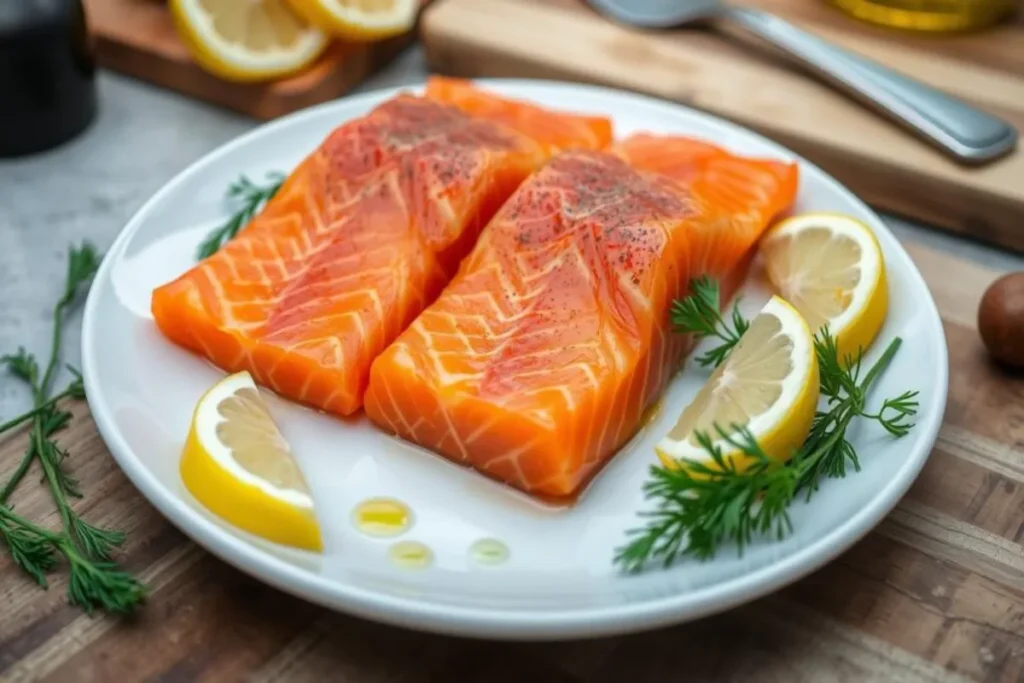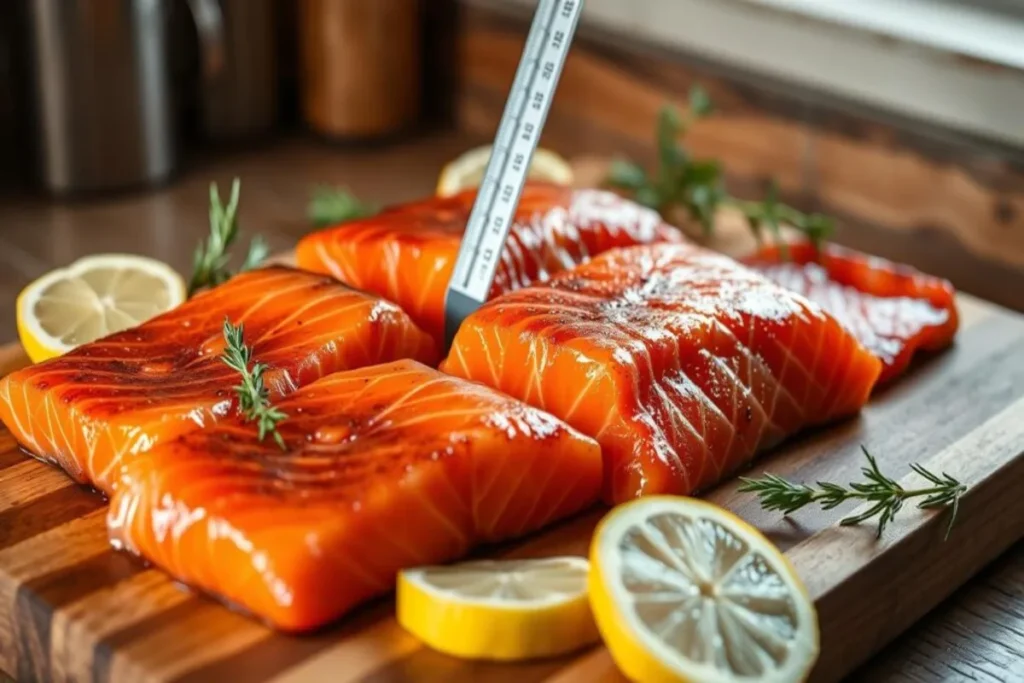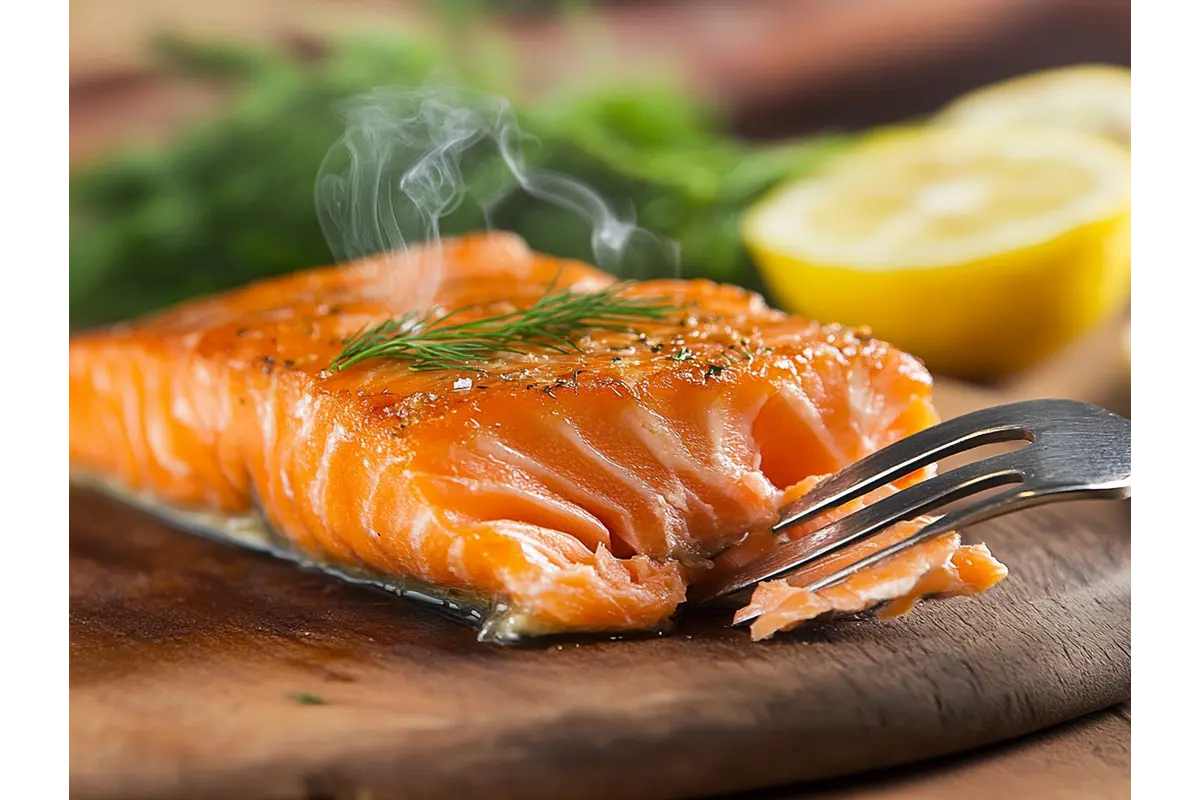Imagine the smell of smoked salmon in your kitchen. It brings back memories of family times and sunny days by the water. The wait for that first bite is exciting, filled with joy and flavor.
The question is, How Do I Know if Smoked Salmon is Done? In this guide, we’ll show you five ways to check if it’s done. You’ll learn how to make sure your salmon is tender and moist. It will have the perfect internal temperature for a great taste and texture.
Whether you’re cooking for many or just a few, these tips will boost your confidence. You’ll be able to serve a delicious dish every time.
Table of Contents
Understanding Smoked Salmon Cooking Techniques
Exploring smoked salmon means learning about different cooking methods. You’ll find hot-smoking and cold-smoking, each with its own taste and texture. Knowing these techniques helps you make delicious smoked salmon, following guidelines that suit your taste and safety.
Hot-Smoking vs. Cold-Smoking
Hot-smoking cooks the salmon with smoke. It uses temperatures from 120°F to 175°F for 4 to 6 hours. This makes the salmon flaky and moist, like regular cooked salmon.
Cold smoking, on the other hand, cures and smokes the salmon at 68°F to 86°F for 12 to 18 hours. It gives a silky texture, similar to gravlax. It’s important to handle cold-smoked salmon safely because it’s not cooked during smoking.
Effects of Cooking Temperature on Salmon Texture
The cooking temperature greatly affects smoked salmon’s texture. Hot smoking makes it tender and flaky. Cold smoking keeps it silky, thanks to brining for moisture.
Using a smoked salmon thermometer is key. It helps you reach the right internal temperature. This is important for both safety and texture, whether you prefer hot-smoked or cold-smoked salmon.
The Importance of Smoked Salmon Internal Temperature
Knowing the internal temperature of smoked salmon is key for safety and taste. Cooking it right keeps the flavors and texture you love. With some care and the right methods, your smoked salmon will turn out perfectly.
Recommended Internal Temperature for Safety
The USDA says to cook fish, like salmon, at 145°F for safety. This kills off bad bacteria. For a tender, moist salmon, aim for 130-135°F. This keeps it juicy.
Impact of Overcooking on Texture and Flavor
Overcooking salmon makes it tough and dry, like chewing on sawdust. To keep it soft and tasty, watch the temperature closely. Learning how to cook smoked salmon right will help you avoid overcooking.
| Doneness Level | Internal Temperature Range (°F) | Texture Description |
|---|---|---|
| Rare | 110-115°F | Very soft and uncooked texture |
| Medium-Rare | 115-120°F | Soft with a slightly firmer bite |
| Medium | 120-125°F | Classic tenderness with some firmness |
| Medium-Well | 125-140°F | Firm texture, beginning to dry |
| Well-Done | 140-145°F | Dry and crumbly texture |
How do I know if smoked salmon is done?
Figuring out when smoked salmon is ready is easier with careful watching and the right tools. A smoked salmon thermometer is key for checking the internal temperature. This is important for the perfect doneness without losing flavor or texture.
Utilizing a Meat Thermometer
A good meat thermometer lets you accurately check the salmon’s internal temperature. Put the probe into the thickest part of the fish, away from bones. The temperature should hit at least 145 degrees Fahrenheit for safety. This method ensures the salmon stays moist and flavorful.
The Importance of Checking for Carryover Cooking
Carryover cooking is important when taking smoked salmon off the heat. The fish’s temperature can rise by up to 10 degrees as it rests. Knowing this helps avoid overcooking. Check the temperature right before removing it to get tender and moist salmon. Always consider this rise when using your thermometer and adjust as needed.
Key Indicators of Perfectly Smoked Salmon
Knowing when smoked salmon is done can make cooking better. Look for visual and texture clues to ensure it’s just right. Learning these signs helps you make delicious salmon every time.
Visual Cues to Look For
A good smoked salmon looks vibrant orange or pink. It should be moist and shiny, not dry. The best salmon has no white spots in the flesh.
Understanding Flakiness and Color
One key sign is if the salmon flakes easily with a fork. It should be tender but not too soft. A good salmon has a pink or translucent center.
Too much white or a hard center means it’s overcooked. Checking color and flakiness is key. Watching the cooking time helps avoid mistakes.
| Indicator | Description |
|---|---|
| Color | Bright orange or pink hue, with no excessive whiteness |
| Surface Texture | Moist and glistening without dryness |
| Flakiness | Flakes easily when prodded, not mushy |
| Internal Color | Slightly pink or translucent when done, opaque indicates overcooking |
The Role of Brining in Achieving Perfect Doneness
Brining is key in making smoked salmon taste better and feel softer. Knowing the difference between wet and dry brining helps you cook it just right.
Benefits of Wet vs. Dry Brining
Wet brining soaks the salmon in a salty, sugary mix. This keeps it moist and juicy. Dry brining, on the other hand, uses salt and sugar right on the fish. It makes the flesh firmer and the flavor deeper.
Here are some tips to keep in mind:
- Wet Brining: Best for smaller salmon, brine for 6-8 hours for 1-2 pounds. Larger pieces need 12-24 hours.
- Dry Brining: Use 2 parts salt to 1 part sugar. It’s better for a firmer texture and takes 6-12 hours, depending on the fish’s thickness.
How Brining Affects Cooking Time
The brining method you choose affects how long it takes to cook. Brined salmon cooks more evenly, which means less chance of it getting too dry. Here are some important tips:
- Brine at 38-40°F (3-4°C) to stop bacteria from growing.
- Keep the humidity at 70-80% to prevent the salmon from drying out too fast.
- Use brown sugar or maple syrup to add sweetness and help with caramelization.
For a good brine, use 1/2 cup kosher salt and 1/2 cup brown sugar for every quart of water. This improves flavor and affects cooking time.
Smoked Salmon Cooking Time Guidelines
It’s important to know the right cooking time for smoked salmon. This ensures it tastes great and has the right texture. The size of the fillet affects how long it needs to cook.
Average Cooking Times for Different Fillet Sizes
The cooking time for smoked salmon changes with the fillet’s thickness and size. Here’s a guide to help:
| Fillet Size | Cooking Time | Recommended Internal Temperature |
|---|---|---|
| Thin (1 inch) | 2 to 3 hours | 125°F to 135°F |
| Medium (1.5 inches) | 3 to 4 hours | 125°F to 135°F |
| Thick (2 inches) | 4 to 5 hours | 145°F |
| Extra Thick (Over 2 inches) | 5 to 6 hours | 145°F |
Factors Impacting Cooking Duration
Several things can change how long smoked salmon takes to cook. These include:
- Initial Temperature: Starting with salmon at room temperature can shorten cooking time.
- Brining Method: Wet brining retains moisture, leading to slightly different cooking times.
- Smoker Conditions: Fluctuations in temperature can greatly affect how long it takes to reach the desired internal temperature.
- Fillet Thickness: Thicker fillets naturally require longer to cook thoroughly.

By keeping an eye on these factors, you can make sure your smoked salmon is delicious and safe to eat. Knowing the right cooking time and internal temperature is key to great results.
Preparing Your Smoker for Optimal Performance
To get the best-smoked salmon, setting up your smoker is key. You need to control the temperature and pick the right wood chips. These steps help bring out the flavor and cook the salmon just right.
Temperature Control Techniques
Keeping your smoker’s temperature just right is important. Use a smoked salmon thermometer to check both the smoker’s and the salmon’s temperature. Here’s how to get it right:
- Keep the smoker’s temperature between 150-170°F (66-77°C) for hot smoking.
- Check the salmon’s internal temperature; aim for at least 145°F (63°C) for safety.
- For the best moisture, try temperatures around 120-135°F (49-57°C).
Choosing the Right Wood Chips for Flavor
The wood you pick can really change how your smoked salmon tastes. Here are some wood chips that add great flavor:
| Wood Type | Flavor Profile |
|---|---|
| Applewood | Sweet and mild |
| Cherrywood | Fruity with a hint of sweetness |
| Hickory | Strong and hearty |
| Mesquite | Bold and intense |
Soaking wood chips for 30 minutes before smoking makes them work better. It adds moisture, which helps the flavors come out more. Mixing different woods can make your smoked salmon taste even more special.
Essential Tools for Smoking Salmon
To get perfectly smoked salmon, you need the right tools. A two-pronged digital thermometer is key. It lets you check the salmon and smoker’s temperature at the same time. This is important for following smoked salmon cooking guidelines and getting it just right.
Importance of a Two-Prong Digital Thermometer
A thermometer is vital to avoid overcooking your salmon. Overcooking can make it dry and lose its flavor. Choose a thermometer that gives quick and accurate readings. It helps you keep an eye on the cooking without opening the smoker too often.
Other Must-Have Smoking Equipment
- Smoker: Pick a smoker that fits your cooking style, like wood, electric, or pellet.
- Wood Chips: Alder pellets are good for a mild flavor. Apple and Pecan are great alternatives. Hickory gives a stronger taste.
- Cooling Rack: Dry the salmon on a cooling rack after brining. It helps prevent moisture and improves smoking.
- Sharp Knife: A good fillet knife helps in preparing and cutting your salmon.
- Airtight Containers: Store your smoked salmon in these to keep it fresh for up to 3 days.
| Equipment | Purpose |
|---|---|
| Two-Prong Digital Thermometer | Monitor internal temperatures accurately. |
| Reliable Smoker | Provide consistent cooking temperatures. |
| Wood Chips (Alder, Apple, Pecan, Hickory) | Add flavor to the smoked salmon. |
| Cooling Rack | Dry the salmon after brining for optimal smoking results. |
| Airtight Containers | Store smoked salmon for freshness. |
Common Mistakes to Avoid When Smoking Salmon
The smoking salmon right needs focus and knowing what to avoid. A few errors can ruin your dish. Many beginners overcook and forget to brine their salmon.
Overcooking and Its Consequences
One big challenge is avoiding overcooking. The perfect smoked salmon should be between 145°F (63°C) and 165°F (74°C). Going over 165°F (74°C) makes the salmon dry and tough.
To prevent this, use a meat thermometer often. How do I know if smoked salmon is done? Check the temperature and feel the salmon. It should flake easily but stay moist.
Neglecting to Brine the Salmon
Not brining can make the salmon taste bland and feel dry. Brining boosts the fish’s flavor and keeps it moist. For best results, brine for 2 to 4 hours with a mix of 1/4 cup salt and 1/4 cup sugar per quart of water.
| Mistake | Consequences | Solutions |
|---|---|---|
| Overcooking | Dry and tough salmon | Monitor internal temperature; keep it between 145°F (63°C) and 165°F (74°C) |
| Neglecting to brine | Lack of flavor and moisture | Brine for 2 to 4 hours for optimal seasoning |
| Using inaccurate tools | Uneven cooking and doneness | Utilize a reliable meat thermometer for accurate readings |
| Improper smoking temperature | Burnt or undercooked results | Maintain smoker temperature between 225°F to 275°F (107°C to 135°C) |
Knowing these common mistakes helps you improve your smoking skills. You’ll enjoy perfectly cooked salmon that tastes amazing.
Additional Tips for Perfect Smoked Salmon
To make perfect smoked salmon, pay close attention to several details. Knowing when smoked salmon is done is key to improving your cooking skills. The quality of the salmon and the cooking technique are also important.
Choosing the Best Quality Salmon
Choosing high-quality salmon is vital for a great dish. Look for salmon that feels firm and smells fresh. Good vendors offer salmon that meets these standards.
The quality of the fish affects the taste and texture of the smoked salmon. The thickness of the fillet also matters as it affects the cooking time. A 2½ to 3-pound fillet might take 1½ to 2 hours to smoke at 250 degrees Fahrenheit.
The salmon should reach an internal temperature of 140 degrees Fahrenheit. This ensures it’s safe and tastes great.
Resting the Salmon Post-Smoking for Best Flavor
After smoking, let the salmon rest for 5 to 10 minutes. This step is important as it helps the juices spread evenly. This makes the salmon more flavorful and moist.
While checking for flakiness can help, resting the salmon is even more important. It makes the dish more enjoyable for everyone. Following these steps ensures a delicious smoked salmon dish.

Conclusion
Learning to make smoked salmon is all about mastering cooking techniques. Knowing how to check if it’s done is key. The USDA says to cook it to 145°F for safety. This way, your salmon stays tasty and tender, no matter if you smoke it hot or cold.
Choosing the right ingredients and brining them well is also important. Use a good thermometer, like the Typhur InstaProbe, to check the salmon’s temperature. With a bit of practice, you’ll make smoked salmon that wows everyone.
So, making perfect smoked salmon is possible. Just follow these tips and pay attention to how it’s cooked. Your hard work will pay off with delicious, memorable dishes. Enjoy the process and make smoked salmon that’s both safe and delicious.
FAQ
How do I know if smoked salmon is done?
Check the internal temperature of your Smoked Salmon using a meat thermometer. It should be at least 145°F for safety. But, for the best tenderness, many chefs say to remove it at 130-135°F.
What is the cooking time for smoked salmon?
Cooking time for smoked salmon varies. It can take from 45 minutes to 3 hours. This depends on the fillet size, thickness, and cooking method. Always check the internal temperature.
What internal temperature should smoked salmon reach?
The USDA says it should be 145°F for safety. But, experts often suggest removing it at 130-135°F. This helps keep it tender and moist.
How can I check the doneness of my smoked salmon?
Use a meat thermometer and look for visual signs. The salmon should be moist and glisten. It should also flake easily with a fork.
What are some visual indicators that smoked salmon is ready?
Good smoked salmon is moist, has a rich color, and flakes easily. If it’s too dry or dull, it might not be cooked right.
Does brining affect the cooking time of smoked salmon?
Yes, brining can change cooking time. Brined salmon cooks more evenly and stays moist. This helps it cook perfectly faster.
What factors impact the cooking duration for smoked salmon?
Cooking time depends on the salmon’s thickness, brining method, and smoker temperature. These factors all play a role.
What are the benefits of using a two-prong digital thermometer?
A two-prong digital thermometer lets you track the salmon and smoker’s temperatures at once. This ensures precise cooking and great results.
What common mistakes should I avoid while smoking salmon?
Avoid overcooking, which makes the salmon dry. Also, don’t forget to brine it to avoid a bland taste. Keep an eye on the internal temperature and brine correctly.
How do I choose the best quality salmon for smoking?
Choose salmon that’s firm and has a little “fishy” smell. Get it from trusted vendors. The quality of your salmon affects the final taste.
Should I let smoked salmon rest after cooking?
Yes, let it rest for 5-10 minutes after cooking. This helps the juices spread, making the salmon taste and feel better.
Follow us on Facebook: https://www.facebook.com/AnyTimesRecipes/
For more information about Salmon’s Temperature, check out: Is salmon done at 145℉ or 165℉? – 5 Critical Differences You Must Know

